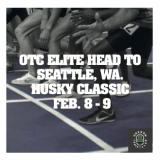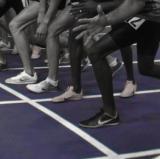Folders |
SYNCOPATION – JIMMY SMITH AND ASTHON EATONPublished by
Jeff Atkinson won the men’s 1500 meters at the U.S. Olympic Trials in 1988, with a closing 400 meter kick of 52.89. When he left high school his coach there told him he would never break 55 seconds in the 400,…….fresh ! I told him he had to run 53 seconds in debt, with a lap to go to win the Olympic Trials. He went on to be a finalist in the 1500 at the Seoul Olympics, and later became the American record holder at the indoor 1500 meter distance. Yet despite these rather impressive achievements ( especially when viewed against the U.S. middle distance scene of the late 80′s ) he never fully bought into how he was being coached. One day he voiced his reservations by stating: You do not coach me like an athlete, you coach me like a jazz musician ! You dumb ass,…. you think you are insulting me, but you just paid me the highest praise possible without even knowing it. That says volume about how much you know about how you got to be an Olympic finalist ! Last week I was driving home from practice when Nancy Wilson was doing her jazz appreciation show on National Public Radio. Before there was a Dionne Warwick, Whitney Houston, or even Alecia Keys, more than a half century earlier, there was Nancy Wilson. I was living in Chicago at the time and at midnight Sid McCoy, the local jazz disc jockey, would come on and with his deep, resonant baritone he would introduce her as “Sweet Nancy, the Baby”. And that is just what she was! Well last week, Sweet Nancy the Baby, was narrating a hour on the work of Jimmy Smith, the premier jazz organist. Various guests would share their impressions and input about the things that made Jimmy Smith the unrivaled master of the jazz organ. A lot of it was pretty mundane and well known rhetoric about his fabulous playing and skill on the instrument. But one of his former sideman’s comment really summed up part of what Jimmy Smith was all about. He pointed out that Jimmy at times during the middle of a number had to pull out the “stops” on the organ to change the sound, tone and timbre the organ produced. Doing this he would get ever so slightly behind the beat and in order to get back on the beat he had to rush to catch up. This produced a heavy syncopation that characterized his playing and allowed him to ever so soulfully swing . Most of Jimmy Smith’s solos were prefaced with a very tight elaborate and virtuoso effort, from which he would release and launch into the most soulful and syncopated rendition possible of the piece. I liken Jimmy Smith’s introductions to the concept often used in track and field called Post Tetanus Potentiation . The concept is based upon the fact that if you aggressively contract muscles prior to performance you can theoretically get up to a 10% increase in contraction. This is most often seen with baseball hitters swinging weighted bats and track and field jumpers, aggressively bounding at the outset of their approach. It was most definitely the case with Jimmy Smith, following the introduction he would take everything to a higher level of excellence and soulfulness. As I was driving I thought about track and field athletes in relationship to certain jazz artists. For example, one of my favorite musicians is Gene Ammons, He was the master of a big, masculine sound that came right at you without apology, hesitation or reservation. David Oliver is very much like Ammons. Ammons would work to get the very deepest and pure sound out of his horn. David works very hard to get the most technical efficieny out of his body. Both David and Ammons share physical size and a dedication to what they value most,…. in its purest form. Aries Merritt reminds me of Paul Desmond, of the Dave Brubeck days. Light, airy, shy, with a certain creativeness tinged with humor. But this is not about Aries or David,.. the track and field athlete I likened to Jimmy Smith is Asthon Eaton. The reason being that organists have to be fluid and multitask with both arms and both legs. The same, to some extent, can be said of drummers. But organists not only keep time with the left foot on the bass pedals, they also have to do a melodic thing with the bass pedals based on the chord changes, while at the same time doing something creative with their other three limbs. So for me, organists are the ultimate multitask people of jazz, thus, they are decathletes or hepthathletes( Shirley Scott ) of their art form . Asthon Eaton is blessed in many ways, but one of the most important is the person who coaches him. Harry Marra graduated from Mount Saint Mary’s College more than 50 years ago. When Vin Linnana, Director of Track and Field/Cross Country at Oregon called me up, and we discussed the pros and cons of hiring Harry Marrra , here is what I shared with him: Vinnie, first of all Harry came from a college that specialized in the decathlon . Jim Deagan, the coach there, always had good multiple event people. So Harry was part of a rich tradition at his school. After graduating he joined our track club in Washington, D.C. We were loaded with talent and Harry fit right in and was a big asset to the team because of the very intense competitive nature he brought to the club. But the most important thing you need to take into consideration is the fact that Harry was a very small guy for the decathlon. So why should I consider his size when he was an athlete then ? I am considering him for a coaching job NOW. Vinnie, when I want to get insight and intuition into the very best way to physically execute something in track and field, I look at women who are good in the event and I look at small guys in the event. For example, if I were looking for efficiency in the high jump, I would immediately look at Stefon Holm of Sweden because he was so small, he had to be doing things right in order to do so well. When we wanted to get the best conversion from horizontal to vertical at take off for Oliver in the hurdles, we modeled his take off technique after Blanka Vlasic. Harry was successful as a little guy in the decathlon because he was efficient and effective despite his size, so he knows things about biomechanical efficiency that other coaches simply do not have. Further the same principal applies to other things related to the sport. Harry had to find the best and most efficient way to handle these things. So I think I am hearing that if I bring him here he will have the feel and intuition about what is the best and most efficient way to get things done. Bingo ! Now lets get to Eaton, Jimmy Smith, jazz and syncopation. Keeping a steady time means that you are on the beat,… and that is rhythm. On the surface that is acceptable,and perhaps to some, even desirable. However, when you lag behind the beat and have to really accelerate to catch up,……….. that is syncopation. In track and field the basic objective for success is strategic force application. The formula for Force is Mass times Acceleration. When Jimmy Smith lags behind when he is adjusting the “stops”, he has to accelerate to catch up and swings harder and sounds better because he is syncopating more. When Eaton slightly lowers his center of gravity – and slows – in the field events and hurdles before the delivery point, and has to accelerate and explode in order to catch back up to, and even exceed, the previous tempo and beat, he is syncopating, thus applying greater force. With Harry knowing instinctively and intuitively how to strategic exploit that greater force creation , we have the ultimate marriage between a basic jazz principal (creative syncopation) and biomechanics. Because Harry has experienced a lot of what is going on in a first-person-singular fashion, he is better positioned to get the very most out of Eaton. The next time I see either one, I am going to suggest they become Jimmy Smith fans. Atkinson turned 50 years old today. Wonder if he is any jazzier now than 25 years ago ? Brooks T. Johnson spikesandflats.com - Brooks Johnson Blog Read the full article at: spikesandflats.com
More news
|








